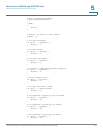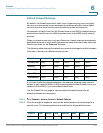
Wireless (for ISA550W and ISA570W only)
Advanced Radio Settings
Cisco ISA500 Series Integrated Security Appliances Administration Guide 249
5
- Select the AUTO radio button if you want the security appliance to
perform a CTS handshake before transmitting a packet. This mode can
minimize collisions among hidden stations.
- Select the Disabled radio button if you want to permanently disable this
feature.
• Power Output: You can adjust the output power of the access point to get
the appropriate coverage for your wireless network. Choose the level that
you need for your environment. If you are not sure of which setting to select,
then use the default setting, 100%.
• Beacon Interval: Beacon frames are transmitted by the access point at
regular intervals to announce the existence of the wireless network. Set the
interval by entering a value in milliseconds. Enter a value from 20 to 999 ms.
The default value is 100 ms, which means that beacon frames are sent every
100 ms.
• DTIM Interval: The Delivery Traffic Information Map (DTIM) message is an
element that is included in some beacon frames. It indicates that the client
stations are currently sleeping in low-power mode and have buffered data
on the access point awaiting pickup. Set the interval by entering a value in
beacon frames. Enter a value from 1 to 255. The default value is 1, which
means that the DTIM message is included in every second beacon frame.
• RTS Threshold: The RTS threshold determines the packet size that requires
a Request To Send (RTS)/Clear To Send (CTS) handshake before sending. A
low threshold setting can be useful in areas where many client devices are
associating with the wireless device, or in areas where the clients are far
apart and can detect only the access point but not other clients. Although a
low threshold value consumes more bandwidth and reduces the throughput
of the packet, frequent RTS packets can help the network recover from
interference or collisions. Set the threshold by entering the packet size in
bytes. Enter a value from 1 to 2347. The default value is 2347, which
effectively disables RTS.
• Fragmentation Threshold: The fragmentation threshold is the frame length
that requires packets to be broken up (fragmented) into two or more frames.
Setting a lower value can reduce collisions because collisions occur more
often in the transmission of long frames, which occupy the channel for a
longer time. Use a low setting in areas where communication is poor or
where there is a great deal of radio interference. Set the threshold by
entering the frame length in bytes. Enter a value from 256 to 2346. The
default value is 2346, which effectively disables fragmentation.


















